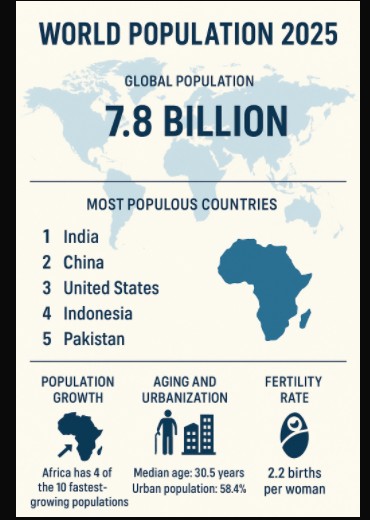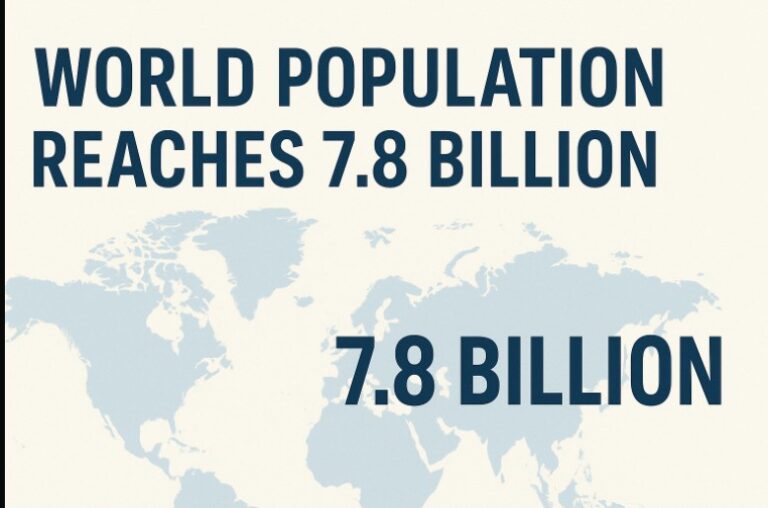New York, United States
The global population has reached an estimated 7.8 billion people, according to the United Nations First Quarter Demography Report for 2025, marking a subtle but significant milestone in the evolution of the human population amid uneven growth across continents.
The report, released by the UN Department of Economic and Social Affairs (UNDESA), underscores the complexity of population dynamics in a post-pandemic world increasingly shaped by technological disruptions, climate volatility, and migration pressures. While the global figure signals continuity, it also masks deeper demographic transformations that are beginning to reconfigure economies, labour markets, healthcare systems, and geopolitical relations.
Key Takeaways from the UN Report
- Total Global Population: 7.8 billion as of Q1 2025
- Top Five Most Populous Countries:
- India – 1.44 billion
- China – 1.39 billion
- United States – 342 million
- Indonesia – 283 million
- Pakistan – 249 million
- Africa: Home to four of the ten fastest-growing populations, led by Nigeria, Ethiopia, DR Congo, and Tanzania.
- Median Global Age: 30.5 years (up from 29.7 in 2020)
- Global Urban Population: 58.4% (up from 56.2% in 2020)
- Average Global Fertility Rate: 2.2 births per woman (declining steadily from 2.5 in 2015)

Africa’s Population Surge: A Double-Edged Sword
The most striking shift in the report is Africa’s sustained population expansion. The continent now houses over 1.5 billion people, accounting for nearly 20% of the global total — up from 13% two decades ago. Nigeria, the continent’s most populous country, is projected to overtake the U.S. by 2050 if current trends continue.
Experts warn that while this growth presents a demographic dividend, it could quickly devolve into a crisis if infrastructure, education, and employment systems do not keep pace.
“Africa’s youthful population is both an opportunity and a challenge,” says Dr. Maria Essien, a demographer based in Nairobi. “The question is whether countries can invest fast enough in human capital to absorb the millions entering the workforce.”
Aging Societies in the Global North
Meanwhile, Europe, East Asia, and North America are grappling with aging populations. Japan’s median age now stands at 49.3 years, the highest in the world, while Germany and Italy also report declining fertility and shrinking workforces.
This trend is prompting urgent policy debates over pension reform, immigration policy, and automation in care sectors. The UN warns that without structural changes, many developed economies may struggle to sustain economic productivity and healthcare financing.
Urbanization and Megacity Growth
More than 4.5 billion people now live in cities — a number projected to rise to 6.6 billion by 2050, with 90% of the increase occurring in Asia and Africa. Lagos, Kinshasa, Dhaka, and Karachi are among the fastest-growing megacities.
This explosive urban growth raises concerns about sustainable development, housing, transport, and access to basic services.
“Urban resilience will define the next generation of development planning,” the report states. “The rise of informal settlements, infrastructural stress, and climate risk converge most acutely in these rapidly urbanizing zones.”
Migration: Rising and Diversifying
International migration remains high, with over 295 million people living outside their country of birth — about 3.8% of the world’s population. The primary drivers include conflict, economic instability, and climate-related displacement.
The report flags a rise in intra-African migration, particularly within West and East Africa, and notes increasing south-south migration patterns globally.
Climate, Conflict, and Fertility: Interlinked Forces
Climate change is already reshaping demographic realities. Prolonged droughts in the Sahel, sea-level rise in island nations, and erratic weather patterns are displacing populations, undermining food security, and driving urban migration.
Meanwhile, fertility rates are declining in nearly all regions except sub-Saharan Africa. In some East Asian countries, like South Korea and Taiwan, birth rates have plummeted to below 1.1 births per woman.
“We are entering a world of demographic divergence,” says UN Population Division Director, Liu Zhenmin. “While some countries struggle with overpopulation, others are entering a phase of irreversible decline.”
Implications and Forward Planning
The UN urges countries to treat demographic data not as a forecast, but as a call to action.
Policymakers are encouraged to:
- Expand education and job creation in high-growth regions
- Reform social protection systems for aging populations
- Plan climate-resilient cities
- Ensure humane and coordinated migration frameworks
- Invest in data collection and national statistics capacity
The first quarter of 2025 confirms a new demographic reality: one of contrast, complexity, and consequence. As the world crosses the 7.8 billion mark, the challenge lies not just in numbers, but in preparedness. Whether demographic trends become a blessing or a burden depends on how governments, communities, and international partners respond — urgently and wisely.
